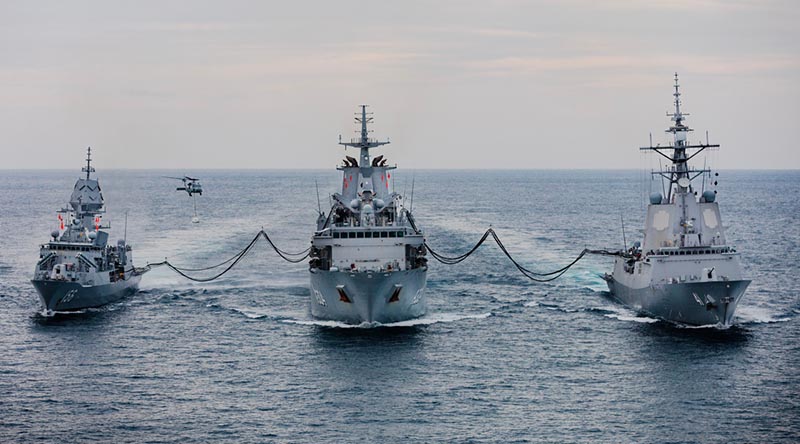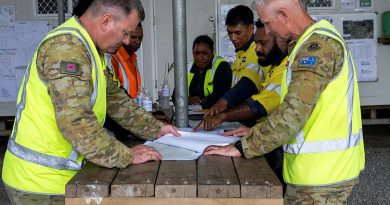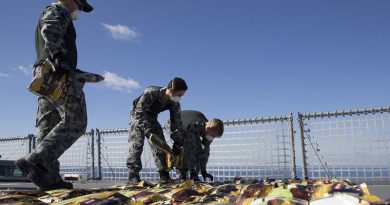Royal Australian Navy’s future surface combat fleet set to expand
Share the post "Royal Australian Navy’s future surface combat fleet set to expand"

The Albanese Government has released its blueprint for future Royal Australian Navy surface combatant fleet – covered in party-political spin [removed, as best as possible hereunder].
FILE PHOTO (November 2023): HMAS Stalwart conducts a dual replenishment at sea with HMA Ships Toowoomba and Brisbane during an Asian regional presence deployment. Photo by Leading Seaman Daniel Goodman.
This announcement and details follows months of government consideration of the recommendations of an independent analysis of the surface combatant fleet commissioned in response to the Defence Strategic Review.
Defence Minister Richard Marles [who prefers to call himself Deputy Prime Minister, even when speaking about the Defence portfolio] said Australia’s strategic circumstances required a larger and more lethal surface combatant fleet, complemented by a conventionally armed, nuclear-powered submarine fleet.
“Navy’s future fleet will be integral to ensure the safety and security of our sea lines of communication and maritime trade, through operations in our immediate region,” Mr Marles said.
“This fleet will constitute the largest number of surface combatants since WWII.”
Mr Marles said the independent analysis of Navy’s surface combatant fleet lamented the current surface combatant fleet was the oldest fleet Navy has operated in its history, and emphasised the need for immediate action to boost Navy’s air defence, long-range strike, presence and anti-submarine-warfare capabilities.
Navy’s future surface combatant fleet will comprise:
- Three Hobart-class air warfare destroyers [already in the fleet]
- to be upgraded with the latest US Navy Aegis combat system
- Six Hunter-class frigates to boost Navy’s undersea warfare and strike capabilities [three fewer than the previous government’s plan]
- 11 new general purpose frigates that will provide maritime and land-strike, air-defence and escort capabilities
- Six new large, optionally crewed surface vessels (LOSVs) that will significantly increase Navy’s long-range strike capacity [this option not on previous government’s plans]
- Six Anzac-class frigates (the two oldest ships to be decommissioned as per their planned service life) [this option not on previous government’s plans]
Total = 26 major surface combatants [previous government’s plan was for 12]
The government has also accepted the independent analysis’ recommendations to have 25 minor war vessels to contribute to civil maritime security operations, which includes six offshore patrol vessels (OPVs).
The Hunter-class frigates will be built at the Osborne shipyard in South Australia, and will be followed by the replacement for the Hobart-class destroyer.
Two Anzac-class vessels will be decommissioned close to their original planned withdrawal from service.
The six remaining Anzac-class frigates will be upgraded with enhanced maritime strike capabilities.
The planned Transition Capability Assurance (TransCAP) upgrades to the Anzac class will not proceed.
The new general-purpose frigates will be modern, capable and more lethal, requiring smaller crews than the Anzac.
Consolidation of the Henderson precinct is currently underway, as recommended by the Defence Strategic Review.
Successful and timely consolidation will enable eight new general-purpose frigates to be built at the Henderson precinct, and will also enable a pathway to build six new LOSVs in Western Australia.
The government said it was committed to continuous naval shipbuilding in Australia and the design of Navy’s future fleet will provide a stable and ongoing pipeline of work to the 2040s and beyond.
Budget
In order to implement the recommendations of the independent analysis, the government has committed to funding the planned acquisition and sustainment of the future surface fleet.
This will see an additional $1.7 billion over the Forward Estimates and $11.1 billion over the next decade in Defence for an accelerated delivery of Navy’s future surface combatant fleet and to expand Australia’s shipbuilding industry.
This comes on top of an additional $30.5 billion to Defence’s Integrated Investment Program out to 2032-33.
The additional $11.1 billion of funding for the future surface fleet alone brings both acquisition and sustainment investment in the fleet to $54.2 billion in total over the next decade.
Minister Marles said the enhanced-lethality surface combatant fleet would ensure the Royal Australian Navy was optimised for operations in our current and future environment, underpinned by the meticulous assessment conducted by the Independent Analysis Team.
“Australia’s modern society and economy rely on access to the high seas – trade routes for our imports and exports, and the submarine cables for the data that enables our connection to the international economy,” he said.
“The Royal Australian Navy must be able to ensure the safety and security of our sea lines of communication and trade routes as they are fundamental to our way of life and our prosperity.”
Minister for Defence Industry Pat Conroy said the significant advancement in Navy capability that would be delivered under the plan required a strong, sovereign defence industry.
“This plan ensures Navy’s future fleet can meet our strategic circumstances by delivering a larger and more lethal fleet sooner and secures the future of naval shipbuilding in Australia.”
Chief of Navy Vice Admiral Mark Hammond said a strong Australia relied on a strong navy, one that was equipped to conduct diplomacy in our region, deter potential adversaries and defend our national interests when called.
“The size, lethality and capabilities of the future surface combatant fleet ensures that our navy is equipped to meet the evolving strategic challenges of our region,” Vice Admiral Hammond said.
The government thanked Vice Admiral William Hilarides, USN (Retd), Rosemary Huxtable and Vice Admiral Stuart Mayer for their leadership of the independent analysis and contribution to the most comprehensive update to Navy’s fleet in decades.
EDITOR’S NOTE: No mention was made nor budget hinted at in relation to manning this larger fleet.
.
.

.
.
Share the post "Royal Australian Navy’s future surface combat fleet set to expand"





